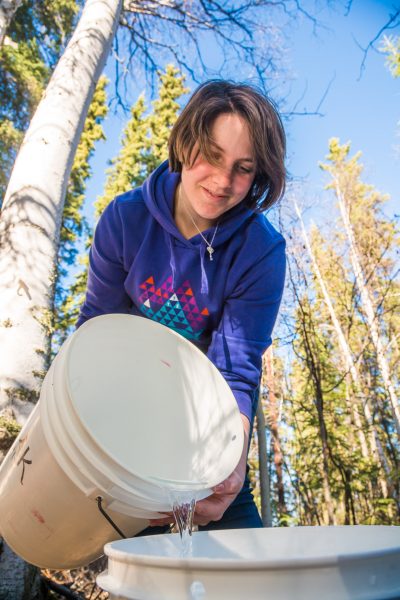Birch trees tapped for sap, research at UAF
April 25, 2016
Debbie Carter
907-474-5406
Anyone walking in the University of Alaska Fairbanks woods this spring might notice
white plastic buckets hanging from trees.

The buckets, which collect birch sap, are emptied daily, and in some cases, more frequently. “If it’s a real gusher, it’s twice a day,” said Jan Dawe, director of the university’s OneTree Alaska program.
Altogether, 250 trees are being tapped for sap this year, including 70 trees on campus and trees in schoolyards, at the Creamer’s Field refuge and other locations around Fairbanks. Staff and volunteers collect the sap, which is then concentrated with a reverse osmosis machine in OneTree’s lab in Lola Tilly Commons. The machine removes a large percentage of the water before the sap is boiled down to syrup.
Last week found Dawe and two assistants, Nicole Dunham and Shaun Johnson, emptying buckets and inserting plastic taps in trees in the mixed spruce and birch woods near the chancellor’s residence. After emptying a bucket, they used a device called a digital refractometer to measure the sugar in the sap.
“At 1.7 Brix, this is one sweet tree,” Dawe said of a tree that provided about a gallon of sap. Brix is a scientific measure of the sugar content. The most prolific trees produce 5-6 gallons of sap daily, although most produce about 1 gallon a day. The sap started running two weeks ago and will continue until just before the trees’ winter buds burst, which, Dawe said, is likely to be this week. Sap collection has already stopped on some south-facing sites.
Dawe initiated the “Tapping into Spring” birch sap project nine years ago as an educational program for area students to learn about the forests, the tapping process and collecting the sap.

She is continuing the educational outreach at five Fairbanks schools this year, but the exercise is also now a research project. She hopes to collect at least 1,500 gallons of sap this year, triple the usual collection, to study different methods of processing the sap and assessing the quality of the product.
Dawe is working with current and potential Alaska birch producers with a goal of providing the best methods for processing sap for a variety of products. She will also work with the UAF Cooperative Extension Service to develop products involving birch sap. Alaska producers currently sell birch syrup and birch sap beverages, mustards, birch almond brittle and more.
Collecting and selling the birch sap has become very popular in Alaska, she said. “Birch sap beverages have a lot of nutritional value.”
Dawe will also test a new reverse osmosis machine. In late April, the metal fabricator from a New York maple products company will install the first commercially available reverse osmosis machine for small-scale sap processing. So far, Dawe has used a much smaller machine made by a graduate student and refined by engineering students.

The new machine is expected to reduce the quantity of sap that needs to be boiled by 75 percent. It will be able to process 100 gallons of birch sap per hour. During that time, the sugar content will double as the sap is reduced by half. The process is repeated until the sap, which comes out of the tree at approximately 1 Brix, reaches 4 to 8 Brix. Then it’s processed further with one of two evaporators fabricated by the New York company. One will run on direct heat with propane; the other on indirect heat through the university's steam system.
Dawe attended the first International Birch Sap and Syrup Conference in New York a year ago, where producers talked about the growing popularity and demand for birch products, and she learned about new innovations in sap processing by maple producers.
She hopes that results from the research will be presented as part of an upcoming Alaska Sustainable Agriculture Conference.


